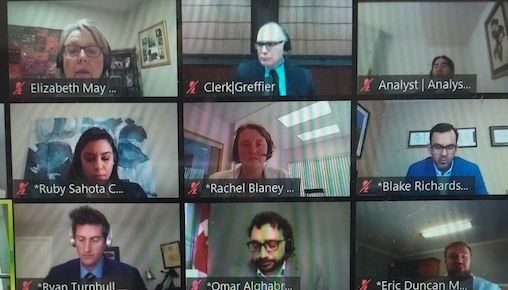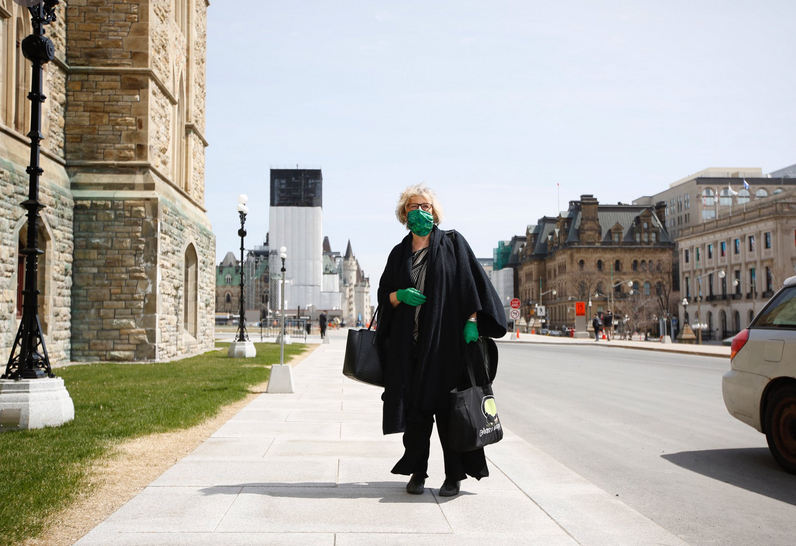Working from Zoom: Adventures in Cyberdemocracy
“The point is, in a pandemic, meeting virtually is better than not meeting at all. And it works.”

via Elizabeth May
Elizabeth May
May 1, 2020
In the first three to four weeks of Pandemic World, this new place where we all live, I worked from home with my somewhat old- fashioned tools. Seven days a week, 16 hours a day, I was simultaneously on the phone, monitoring television news and using my laptop — all the time. Most of that time was subsumed in a frantic effort to help Canadians — including my own constituents — stranded abroad when the world started shutting down, get home. Over time, my workload shifted to helping my constituents deal with the economic impact on them as individuals and as small business owners. And through it all, we have had a daily technical briefing from the government with the opportunity to pose questions to multiple federal departments (including Saturdays and Sundays). I gave Policy magazine readers an early sense of all this after our Easter weekend sitting back in Parliament.
The week after Easter weekend, we started having meetings of parliamentary committees by tele-conference, but that quickly moved to video meetings. Not surprisingly, the first committee to meet in a virtual video “face-to-face” meeting was the Standing Committee on Parliamentary and House Affairs (PROC). By the unanimous consent motions of March 25th, PROC had been given the mandate to study and prepare a report on how Parliament could meet virtually. Events have nearly eclipsed PROC’s work. On April 21, PROC became the first standing committee to meet on Zoom.
I have now been through at least a dozen meetings of standing committees (PROC, Finance, Government Operations and Estimates), one virtual meeting of the new COVID-19 committee – the one with 338 members – and one in-person meeting of the COVID committee back in the House with the new system of question period giving any MP recognized to ask a question a five-minute round.
We have not had any off-mic bloopers of the magnitude of the Welsh parliament in which Minister Vaughn Gething was heard swearing at one of his own MPs when he thought he was muted. Excellent viewing, if you missed it.
For the most part, virtual sessions have gone quite well.
It was Conservative Leader Andrew Scheer who led the charge to insist democracy was not respected if we did not meet in person. I have made it very clear, through media and speeches in the House, that every time we meet in person, we increase risks to our own health and to the minimum number of House of Commons personnel who must show up too. It strikes me as a continual irony that Scheer never complained about Stephen Harper shuttering Parliament in the 2008 financial crisis, when a minority prime minister prorogued to avoid a confidence vote he knew he would lose. But now the Conservative rallying cry is that democracy requires we meet face-to-face in a pandemic.
The compromise motion of April 20th allows for one in-person session every Wednesday, and virtual meetings on Tuesdays and Thursdays. The meetings are of the COVID-19 committee, unless we move to House business to pass legislation, as we have done three times since March 13th.
The delineations between who likes virtual meetings and who doesn’t are entirely predictable.
The Conservatives make a great point of not liking their internet, not hearing properly and having all manner of difficulties. The Liberals, Bloc, NDP and Green MPs manage just fine. Or at least when we have technical glitches such as Paul Manly’s star turn in front of a green screen, we take it in good humour.
 David Kawai/Twitter
David Kawai/Twitter
No one would argue that it was time to get rid of physical sessions of Parliament if we were not facing a deadly health threat. Of course, meeting in person is vastly superior to meeting virtually. The point is, in a pandemic, meeting virtually is better than not meeting at all. And it works.
My Green Party colleague in the Parliament at Westminster, Caroline Lucas, MP for Brighton Pavilion, described how her Wednesdays have changed since the U.K. adopted its “hybrid model,” in which some MPs come in person and others appear on video screens in the chamber itself:
“There is a pattern for Wednesdays in Parliament. Prime Ministers’ Questions always fills the Commons chamber and MPs need to arrive early to guarantee a seat. That means leaving a ‘prayer card’ on your chosen place first thing in the morning so colleagues know you’ll be returning, and then claiming your seat before the 12.00 start. But not this week. Instead of rushing to the Chamber, I was re-arranging the items on the bookshelf in my home so that when I appeared on screen for the first virtual session, it wouldn’t look like I had a lampshade on my head or a plant coming out of my ears.”
The U.K. Parliament has issued its first report on how things are working. For Canadian MPs, with our five time zones and the travel implications of reduced connections, making my trip back to Ottawa more than 24 hours long, this excerpt from the UK report is almost funny:
“Several find it impossible to travel to Westminster without taking public transport, which carries an evident risk of infection. Long-distance travel has been restricted to the extent that many Members from constituencies distant from London now find it impossible or impractical to travel under current circumstances.”
The conclusion I draw contrasting U.K. Conservatives to Canadian Conservatives is that how you feel about whether parliament must meet in person rather than virtually depends on whether you are in or out of government.
And, as ever, for Greens, we are in complete accord. Let us stay home and meet virtually.
Policy magazine Contributing Writer Elizabeth May, MP, is leader of the Green Parliamentary Caucus.
